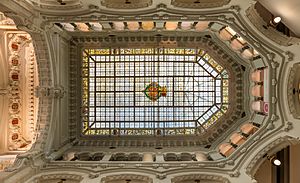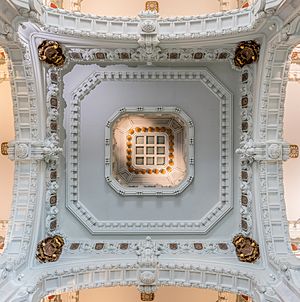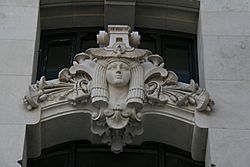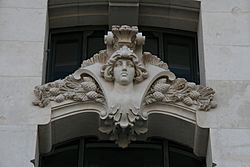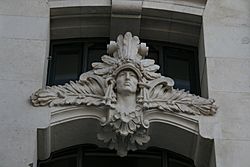Cybele Palace facts for kids
Quick facts for kids Cibeles Palace |
|
|---|---|
|
Palacio de Cibeles
|
|
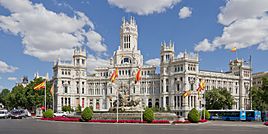
Cybele Palace, with the fountain of the same name in the foreground
|
|
| Former names | Palacio de Comunicaciones Palacio de Telecomunicaciones |
| General information | |
| Status | Complete |
| Architectural style | Eclecticism Neo-Plateresque |
| Location | Madrid, Spain |
| Coordinates | 40°25′08″N 3°41′32″W / 40.418906°N 3.692084°W |
| Current tenants | Ayuntamiento de Madrid |
| Inaugurated | 1919 |
| Height | |
| Architectural | Spanish Property of Cultural Interest |
| Design and construction | |
| Architect | Antonio Palacios Joaquín Otamendi |
The Cibeles Palace (in Spanish: Palacio de Cibeles) is a grand building in Madrid, Spain. It was once known as the Palace of Communications (Palacio de Comunicaciones) and the Palace of Telecommunications (Palacio de Telecomunicaciones) until 2011. This impressive complex has two white buildings. It stands in a historic part of Madrid.
For many years, it was Madrid's main post office. It also housed the city's telegraph and telephone services. Today, the Cibeles Palace is home to the Madrid City Council. This means it serves as the city hall. It also has a public cultural center called CentroCentro.
Contents
About the Cibeles Palace
The Cibeles Palace is located next to the famous Plaza de Cibeles. It covers about 30,000 square meters. This area used to be part of the old gardens of the Buen Retiro Park. Some people were not happy about building there. They felt it took away green space from Madrid.
Construction of the palace began in 1907. It officially opened on March 14, 1919. At first, it was a modern center for mail, telegraphs, and telephones. Later, the building changed. Two floors were added, and it became home to Madrid's city offices in 2007. The city government moved from its old buildings, the Casa de la Villa and the Casa de Cisneros. This big change also added the "CentroCentro" cultural area.
The palace is a great example of Spanish architecture. It shows an early style called Modernismo madrileño. It has a special look with its Neo-Plateresque front and Baroque details. Young Spanish architects Antonio Palacios and Joaquín Otamendi designed the building. They won a city competition to create the headquarters for the Post and Telegraph Society of Spain. The decorative parts of the building were made by sculptor Ángel García Díaz. The goal was to build "a building for the public."
Over time, the building needed repairs. Changes were made in the 1960s and later, to improve communication systems. As people used postal mail less, the palace's role changed. In 1993, it was named a Bien de Interés Cultural. This means it's an important cultural monument. In the early 2000s, it became part of the city's property. It then transformed into a cultural center and the seat of Madrid's City Council.
A Look Back: The Palace's History

Madrid grew a lot in the 17th century. King Philip II of Spain made it the country's main administrative and political center. The Calle de Alcalá, a main street, stretched from Puerta del Sol to Paseo del Prado. As Madrid's population grew, postal services became very important. A "Royal House of Letters" was built for this purpose.
The old post office building was in the city center. This caused traffic and slow communication. So, a new "Palace of Communications" was needed. The area around Paseo del Prado and Recoletos became popular for important buildings. Many grand mansions and institutions were built there.
The famous Fountain of Cybele was placed nearby in 1794. The square was first called Plaza de Madrid, then Plaza de Castelar. The gardens of the Buen Retiro Park reached the Paseo del Prado. These gardens seemed like the perfect spot for the new post office. Other old buildings were taken down to make way for new ones, like the Bank of Spain.
In 1910, work started on a new main road called Gran Vía. This new road aimed to change how traffic flowed in the city.
Building the Palace: A Long Journey
It took twelve years to finish the Cibeles Palace. There were many delays and disagreements during this time. The design was approved in 1905, and construction began in 1907. But the work stopped and started for a few years. This was due to political changes and different opinions. Some groups even asked for the project to be canceled.
The construction picked up speed when a new political party came into power. The architects, Palacios and Otamendi, also worked on other big projects in Madrid during this time.
Work officially started on September 12, 1907. A company called Toran and Harguindey was in charge. A special engineer, Ángel Chueca Sainz, designed the metal parts of the building. People jokingly called the building "Our Lady of Communications." This was because of its huge size and grand look.
In 1916, the Public Postal Savings Bank opened its doors in the palace. Even then, the building was not fully finished. A lot of materials were needed for construction. This included thousands of tons of iron, stone, and bricks. Many artists and craftspeople helped with the decorations.
By 1916, people could see many finished parts of the building from the street. The total cost of the building was about twelve million pesetas. This was almost three times more than first planned.
Opening Day and Early Years
After twelve years, the Cibeles Palace officially opened on March 14, 1919. It was called the "Cathedral of Communications." The King and Queen, Alfonso XIII and Victoria Eugenie, attended the celebration. They were joined by government officials.
The palace quickly became a symbol of progress and modernity for Spain. It was the main center for communications in Madrid. Just one year later, it became the international headquarters for the Universal Postal Union. One of its first jobs was to handle all the mail traffic.
- Decoration around the windows on the main facade
In 1931, the Second Spanish Republic was declared. The flag of the new Republic was raised on the palace's front. During the Spanish Civil War, Madrid was bombed. But the Cibeles Palace did not suffer much damage. You can still see bullet holes on its white walls today. These marks are from a battle in March 1939, near the end of the war.
Changing Roles: From Post Office to City Hall
Telegraph services in Spain grew until 1987. During this time, the building was repaired and its outside walls were cleaned. After 1994, the use of the building as a post office started to decline. By 2005, it was mainly used for residential mail, with fewer than 500 users.
In 2003, plans began to change the Cibeles Palace. Madrid's City Council needed more space. Their old buildings were too small. So, it was decided to move the city government to the grand Cibeles Palace.
The first city offices, including the mayor's office, moved in 2007. The city council held its first meeting in the palace in 2011. The old city hall building is still owned by the city. It is now used for special events and receptions.
See also
 In Spanish: Palacio de Cibeles para niños
In Spanish: Palacio de Cibeles para niños


